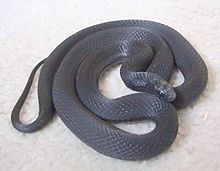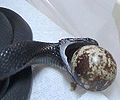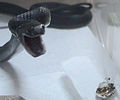Dasypeltis
| Dasypeltis | |
|---|---|

| |
| Montane egg-eating snake (Dasypeltis atra) | |
| Scientific classification | |
| Kingdom: | |
| Phylum: | |
| Subphylum: | |
| Class: | |
| Order: | |
| Suborder: | |
| Family: | |
| Subfamily: | |
| Genus: | Dasypeltis A. Smith, 1842
|
| Species | |
|
12 recognized species, see article. | |
Dasypeltis is a genus of colubrid snakes. It is one of only two taxonomic groups of snakes known to have adapted to feed exclusively on eggs (the other being the genus Elachistodon). They are non-venomous and found throughout the continent of Africa, primarily in forested or wooded habitats that are also home to numerous species of birds.
Species
Dasypeltis has 12 recognized species:[1]
- Dasypeltis abyssina (A.M.C. Duméril, Bibron & A.H.A. Duméril, 1854)
- Dasypeltis atra Sternfeld, 1912 - montane egg-eating snake
- Dasypeltis confusa J. Trape & Mané, 2006
- Dasypeltis fasciata A. Smith, 1849 - Central African egg eating snake
- Dasypeltis gansi J. Trape & Mané, 2006
- Dasypeltis inornata A. Smith, 1849 - southern brown egg-eating snake
- Dasypeltis latericia J. Trape & Mané, 2006
- Dasypeltis medici (Bianconi, 1859) - East African egg-eating snake
- Dasypeltis medici lamuensis Gans, 1957
- Dasypeltis medici medici (Bianconi, 1859)
- Dasypeltis palmarum (Leach, 1818)
- Dasypeltis parascabra S. Trape, Mediannikov & J. Trape, 2012
- Dasypeltis sahelensis J. Trape & Mané, 2006
- Dasypeltis scabra (Linnaeus, 1758) - common or rhombic egg-eating snake
- Dasypeltis scabra loveridgei Mertens, 1954
- Dasypeltis scabra scabra (Linnaeus, 1758)

Description
The species of this genus exhibit a wide variation in patterning and color, from mixtures of browns and greens, to solid black. Individuals in a specific locality tend to share similar color and pattern. They vary in size greatly, from 30-100 cm (12-39 inches) in length.
Behavior
Dasypeltis species tend to have a nervous disposition, and when threatened will perform what is called saw-scaling, where it will rub its scales together quickly to make a rasping noise that sounds vaguely like hissing. They are agile climbers, and have a keen sense of smell to tell whether an egg is rotten or too far developed to be comfortable to eat. They have extremely flexible jaws and necks for eating eggs much larger than their head, and have no teeth, but they do have bony protrusions on the inside edge of their spine which are used to aid in breaking the shells of eggs.
The process of consuming an egg involves wrapping their mouth around it and drawing it into the throat and then flexing their muscles pushing the egg into the bony protrusions on their spine, which causes the egg to collapse in on itself. Then the snake carefully squeezes every last bit of liquid out of the inside of the egg, ending with regurgitation of the completely crushed egg shell. They are remarkably efficient, and waste very little of the contents of an egg.
Eating
A sequence of a Montane Egg-eating Snake, Dasypeltis atra consuming a quail egg.
In captivity
Dasypeltis species are readily available in the exotic pet trade, but due to their unique dietary needs they can be a challenge to keep in captivity. Most egg-eating snakes never get large enough to consume typical chicken eggs, so smaller ones must be provided, such as finch eggs or quail eggs. Once a reliable source(s) of food is obtained, Dasypeltis make easy and hardy vivarium species. Captive breeding is virtually unknown, so almost all specimens available are wild caught.
Many owners have resorted to force feeding their Dasypeltis because the animal seems not to be eating. However, evidence has shown that, like large constrictors, these snakes may go for very long periods (months) without eating after a large meal. As long as the snake is behaving normally and does not appear to be in physical distress, force feeding is not advised. When a specimen seems to be "off" its food, offering it eggs approximately monthly is appropriate. If the snake does not eat but continues to drink, is active, and sheds, then it does not need to be force fed.
References
- ^ The Reptile Database. www.reptile-database.org.
- Genus Dasypeltis at The Reptile Database




